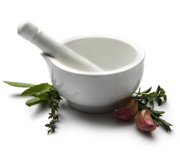
|
Breast Health At one time or another, the thought of breast cancer has most likely entered each of our minds — with either concern for ourselves or for someone we love. The amount of research done on breast cancer treatment and prevention is exciting, but my own experience with patients reveals that there are less widely known options and lifestyle changes available to women. Most of us have heard about estrogen and its role in women's health but may not understand exactly how it works. Estrogen plays a key role in building bones, maintaining cardiovascular health, libido and healthy skin tone and in initiating breast development in puberty. Excessive estrogen can lead to PMS, cramping and pain with periods and an increased risk of breast cancer. Proper elimination of estrogen begins in the liver, where it is broken down in two phases. In Phase I, estrogen enters the liver, and the liver breaks it down into 2-hydroxyestrone (2-OH), 16alpha-OH and 4-OH. The 2-OH is commonly referred to as the "good estrogen" because it generates a less harmful estrogenic effect on the body. Breast cancer is associated with increased levels of 16alpha-OH and 4-OH. Thus the greater the shift to the 2-OH type, the less chance of breast and other types of cancer. The best way to help with Phase I detoxification is to eat foods high in isoflavones, especially cruciferous vegetables such as broccoli, cabbage, Brussels sprouts and cauliflower. I call these the "wonder foods," since they support liver detoxification and increase levels of the "good" 2-OH. The fiber produced by these vegetables also helps carry away unhealthy estrogens through the stool. Rosemary and curcumin, a compound found in turmeric, are wonderful spices that inhibit the "bad" 16alpha-OH estrogen and promote 2-OH. In the second phase of detoxification, if the 16alpha-OH estrogen metabolites are not properly detoxified, they become very harmful and can damage DNA, further raising the risk of cancers. To promote Phase II detoxification, folic acid, B6 and B12 are needed. These help reduce the level of damage to your DNA caused by estrogen. (See also "Spring Cleaning" in issue #1.) In addition to balancing "good" and "bad" estrogens, certain plants called phytoestrogens are similar to estrogen in chemical structure and can bind to estrogen receptors. The benefit of this is that these plants can prevent the receptor-binding of stronger estrogens that can promote cancer. The two main classes of phytoestrogens are isoflavones (see above) and lignans. Lignans are found in foods such as flaxseed, whole grains, legumes and certain vegetables. One of the easiest non-dietary ways to promote normal estrogen metabolism is through exercise. Last summer, one study concluded that women who had breast cancer and walked 30 minutes a day five times per week had a 50 percent decrease in recurrence rates compared to those who did not. Exercise "burns" estrogen and helps eliminate the "bad" types of estrogens. Research, as well as my own experience, identifies several factors that may predict your risk for poor estrogen metabolism: family history of breast cancer, cystic breasts, endometriosis, ovarian cysts, severe PMS with or without cramping and blood sugar problems such as pre-diabetic or diabetic conditions. If a woman thinks she may be at risk, I suggest doing a blood or urine test to measure the estrogen metabolites 2-OH and 16alpha-OH. As of yet, I haven't seen a good test available to the public that can measure 4-OH. If a woman has had breast cancer, this test is a must. It is also a good screening test to do every few years to be sure the estrogen is balanced. Mammograms may also be effective in helping detect breast lesions. Some women have expressed concern about the radiation exposure and would like an alternative. In that case, I have found that using a machine called Computer Regulation Thermography (CRT) may detect problems in the breast earlier than a mammogram would. It analyzes measurements of heat from the body by computer. If there is a large temperature difference in the breast compared to elsewhere in the body, this indicates an abnormality in that specific tissue. The test is noninvasive and easy to perform.
|
|
To maintain good health and vitality (for women): Folic acid: 800 mcg a day Resource: How to Prevent and Treat Cancer with Natural Medicine by Dr. Michael Murray, et al.
|
